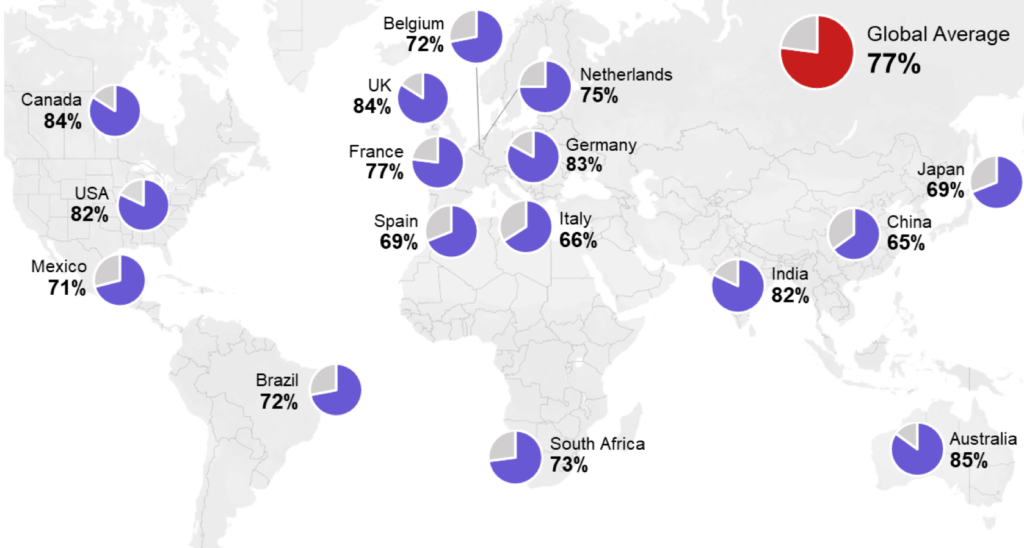Remote working is no news to the business world. For the last 10 years, working remotely has not been the norm, but a way of working for people overseeing multiple locations of a business, or covering regional roles. In 2016 it was identified as a trend, and it was projected that in 2018 half of the US workforce will have been moved to the remote-working model. It has also been noticed that EU remote workers have increased by +2,4% during the last decade. Technology like videoconferencing software, collaboration platforms, and cloud services keep people connected and allow them to have meetings and complete projects anywhere, anytime.
Personally, I have worked remotely myself, as a regional HR Business partner for an organization, which operated under a group of companies. At that time, a lot of projects were initiated, aiming at the company’s HR transformation. The latest required the synchronization of actions of all the project’s team members across the country. Naturally, this could not always be achieved through actual physical meetings, so virtual meetings were a means that enabled constant communication for the coordination of the project developments. I must admit that even before Zoom was launched, the use of conference calls, Skype For Business, Microsoft Teams and Cisco WebEx -to name a few- fit the purpose, and resulted in virtual communications being used to coordinate both meetings and calls. Project milestones were achieved, with all employees from all over the country being able to participate, combined with the ability of stakeholders to constantly be updated for developments. Please note that, under no circumstances, may I try to devalue the great importance of face-to-face interaction and the value of communication between directors, line managers, supervisors, team leaders, and the rest of the team/employees in person. I just wish to highlight that virtual communication and remote work have never been a true obstacle for a project to be completed, and, in my experience, they have never led people to become demotivated or less productive, compared to those working in an office environment. At any occasion, what’ s most important is for each employee to be focused on achieving the completion of a project and the leadership team to focus on providing employees with guidance and support.
When COVID-19 made remote working a temporary normality, the whole world had mixed feelings about the future of working, and individuals had them for their specific jobs. After nearly 4 months having passed, people have a much clearer picture of their preference around the way of working. Therefore, I have been really interested in capturing the views of my network around the topic. The vast majority has expressed the opinion that remote working is the best thing that has ever happened to them, and I feel that I share the same feeling, so I have decided to justify this position.
After conducting some research, I came across some interesting figures from reports on “Where the employees around the world (with a bit more emphasis in the US and the UK) are standing after the COVID-19 crisis in regards to retuning to the office or continuing with remote working”. Keep in mind that for most people, businesses, countries remote working is not the standard way of working. It has been forced as a safety measurement and right now it has transformed to the next work trend.
According to research by Eskenzi PR which took place in the UK, 91% of employees would prefer to have the option to work remotely, when questioned how they would feel about returning to an office environment after the Coronavirus pandemic is over. The report also found that 31% of respondents would prefer to continue working from home every day or four days a week, a quarter would like to work from home one day a week, while over 35% would prefer to work remotely two or three days a week. The majority of respondents aged 23 to 34-years-old (93%) wanted to work from home and employees aged over 55 are the only ones who appeared marginally keener to go into the office, with only 14% wanting to return to the office. Just over a third (36%) of the respondents said that they feel more productive working from home, 34% feel less stressed and over half (54%) believe that they waste their time commuting. A further 23% feel enjoy that their peers or managers are not watching over them.
Yvonne Eskenzi, founder at Eskenzi PR, said: “This survey shows that for the first time ever, people have had a taste of working from home and they love it because they’re more relaxed, they don’t need to travel and can spend time with their family and pets. Interestingly, a third of respondents think the ideal working week would be betters pent half at home and half in the office.”
Based on results of the IWG Global Workplace Survey taking place during the first quarter of 2020, 68% of UK businesses are offering flexible working arrangements to employees. This is just 5% below the global average and brings the UK 6th on the list of the 15 biggest countries participating in the research (after Germany, Netherlands, USA, Canada, Australia). The research has shown that 73% of UK employees expect remote working will be the new norm.
According to the U.S. Census Bureau, nearly one-third of the U.S. Workforce and half of all the “information workers” are able to work from home. With Covid-19, this number has increased to the 98% of people surveyed stating that they would like the option of working remotely for the rest of their careers.
Nearly two-thirds of candidates say that having a choice of work location is a key consideration in choosing an employer.
The top benefits identified from this survey are the ability of employees to have a flexible schedule, find the right work-life balance, work from any location, and avoid commuting. Lockdown measures have highlighted the value of workplace flexibility – particularly for parents. A total of 86% of parents now want to work flexibly, compared to 46% pre-coronavirus.
UK research has revealed additional benefits of working from home reported by remote workers.
- Increment on savings pot: £57.78 around the London area, £47.10 in the North– West. The amounts refer to average savings of each employee per week.
- More free time: The average daily commute time in the UK is now 59 minutes. This means that people working from home will save almost five hours a week that they would normally spend in transit.
- Less pollution: Another benefit for the UK that has been captured during the coronavirus crisis, is the reduced emissions from workers not commuting and from manufacturing or transport companies reducing operations as their employees are able to work from home. As an example, it is said that if those with remote-compatible jobs worked at home half the time, it could result in saving 54 million tonnes of greenhouse gas, equivalent to taking 10 million cars off the road.
Remote working is not a benefit for employees only. Flexible working arrangements can be positive for employers as well. One of the main benefits for companies adopting flexible working is attracting talent. Location flexibility isn’t just a way to keep current employees happy. Companies that don’t embrace flexible working may find themselves in a disadvantage when recruiting new talent. Nearly two-thirds of candidates say that having a choice of work location is a key consideration in choosing an employer.
Forbes supports this current trend, by commenting that employers should start to view remote work as an important part of hiring and retaining top talent, staying competitive in their field, and even saving on business costs.
% Of global businesses that are using flexible workspace policies to attract and retain top talent

IWG Global Workplace Survey Participants: Over 15,000 business people across 80 nations. Date: March 2019
Of course there are some concerns around remote working from both sides.
Employees top concerns:
For U.S remote workers a top issue faced was “unplugging” from work. Without the clear-cut change of location and defined office hours, many people had a tougher time clearly dividing their personal and professional time.
Moreover, the lack of person-to-person communication can be a challenge for some people. In fact, one-third of the participants were concerned that the full extent of their professional efforts wouldn’t be appreciated because of a lack of in-office contact.
In the UK a percentage of employees working from home have reported that they have faced some issues around well-being and struggling with performance, due to lack of resources.
- 30.9% of remote workers say that they struggle with loneliness
- 22% of telecommuters say that “switching off” after work is their biggest challenge
- 62% of remote workers want employers to provide better technology that helps them stay connected with their colleagues
On this note I can totally understand the factor of “loneliness” when people do not belong or physically work within a team, especially when this was the norm so far. Also a lot of people have associated the work/ office environment with part of their life routine and that is 100% understandable, but in my opinion, it is not a factor that can pragmatically affect productivity when individuals work remotely. If it is though, an employer should consider their duty of care to support those people and put appropriate working-patterns agreements in place.
Personally, I am more of the opinion that “employees who have control over their schedules report finding time to exercise more, eat better, and have higher morale and a better outlook in general.” -American Psychological Association
As for the 62% of remote employees requiring better technology support from employers, we couldn’t agree more. Employers should at all times offer tools and security to remote workers, and all the information systems/ data they need to handle.
Employers top Concerns:
Managers are worried that productivity and focus will be diminished if people are working in informal locations, such as home or a café. Also, if people don’t work in the same physical location, managers feel that team spirit and connectivity, as well as the company culture could suffer.
On the flip side, the cost savings associated with remote work may win many companies over. Research has found that a typical employer can save about $11,000 per year for every person who works remotely, even if it is half of the time. Furthermore, switching to virtual meetings in some instances can also be a significant cost saving factor- especially when a company covers travel expenses for employees to be physically present in a meeting, which will last 60’-90’ maximum.
In my view the Key Take- Away here is that the workforce perception about work is changing and businesses should be able to respond and adapt to this change of behaviors -not the other way around. Individuals prioritize life, they trust their abilities to cope with work and own their time. The data shows that allowing employees to work off-site is the definition of a win-win situation. Productivity goes up, costs come down, and people are happier with their jobs. What’s left now is for businesses to adopt the culture of being employers of choice.
Welcome to the Remote ERA!






